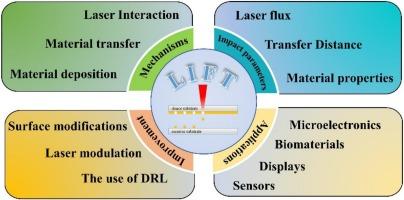A review on laser-induced forward transfer in digital additive manufacturing
IF 5
2区 物理与天体物理
Q1 OPTICS
引用次数: 0
Abstract
Laser-induced forward transfer (LIFT) is a versatile manufacturing technique that represents the most advanced approach to an integrated additive manufacturing method compatible with virtually any material. In this technique, laser radiation is utilized to propel and precisely deposit the desired material at a user-defined position with exceptional spatial resolution. By carefully selecting appropriate laser parameters and considering the intricate interaction between the laser and material, this technique can be successfully applied across a wide range of materials, from solid inorganic substances to delicate biological samples. This paper primarily presents an introduction to the transfer process and mechanism of LIFT and thoroughly analyzing the influential transfer parameters. Furthermore, it summarizes the application and improvement measures of LIFT process. Finally, it provides an overview of challenges and research directions in existing LIFT technology.

数字增材制造中激光诱导前向转移研究进展
激光诱导正向转移(LIFT)是一种通用的制造技术,代表了与几乎任何材料兼容的集成增材制造方法的最先进方法。在该技术中,利用激光辐射推进并精确地将所需材料沉积在具有特殊空间分辨率的用户定义位置。通过仔细选择合适的激光参数并考虑激光与材料之间复杂的相互作用,该技术可以成功地应用于从固体无机物质到精细生物样品的广泛材料。本文主要介绍了升力的传递过程和机理,并对影响升力传递的参数进行了深入分析。总结了LIFT工艺的应用及改进措施。最后,对现有LIFT技术面临的挑战和研究方向进行了概述。
本文章由计算机程序翻译,如有差异,请以英文原文为准。
求助全文
约1分钟内获得全文
求助全文
来源期刊
CiteScore
8.50
自引率
10.00%
发文量
1060
审稿时长
3.4 months
期刊介绍:
Optics & Laser Technology aims to provide a vehicle for the publication of a broad range of high quality research and review papers in those fields of scientific and engineering research appertaining to the development and application of the technology of optics and lasers. Papers describing original work in these areas are submitted to rigorous refereeing prior to acceptance for publication.
The scope of Optics & Laser Technology encompasses, but is not restricted to, the following areas:
•development in all types of lasers
•developments in optoelectronic devices and photonics
•developments in new photonics and optical concepts
•developments in conventional optics, optical instruments and components
•techniques of optical metrology, including interferometry and optical fibre sensors
•LIDAR and other non-contact optical measurement techniques, including optical methods in heat and fluid flow
•applications of lasers to materials processing, optical NDT display (including holography) and optical communication
•research and development in the field of laser safety including studies of hazards resulting from the applications of lasers (laser safety, hazards of laser fume)
•developments in optical computing and optical information processing
•developments in new optical materials
•developments in new optical characterization methods and techniques
•developments in quantum optics
•developments in light assisted micro and nanofabrication methods and techniques
•developments in nanophotonics and biophotonics
•developments in imaging processing and systems

 求助内容:
求助内容: 应助结果提醒方式:
应助结果提醒方式:


